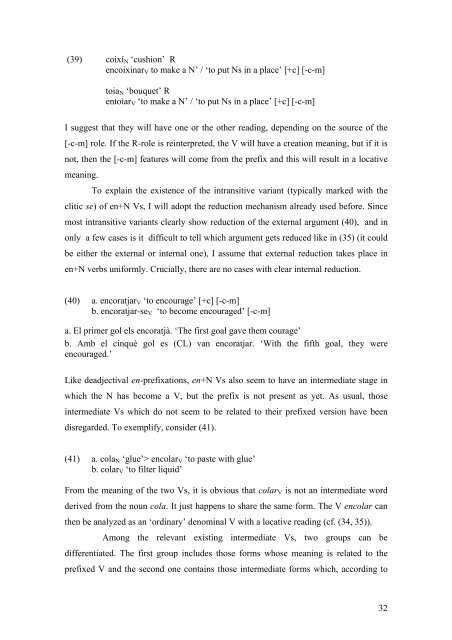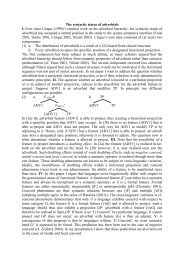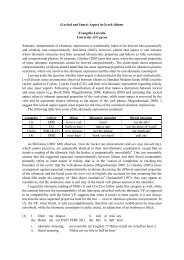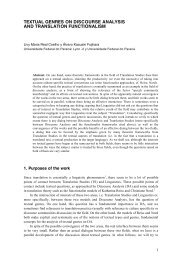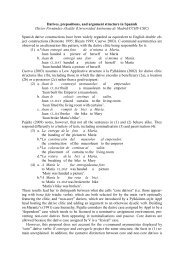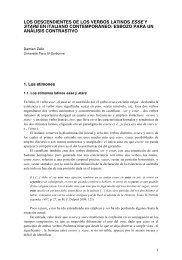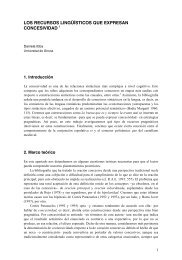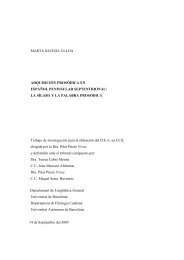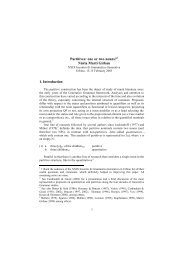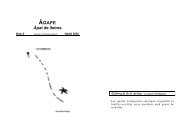Prefixation in English and Catalan - Departament de Filologia ...
Prefixation in English and Catalan - Departament de Filologia ...
Prefixation in English and Catalan - Departament de Filologia ...
You also want an ePaper? Increase the reach of your titles
YUMPU automatically turns print PDFs into web optimized ePapers that Google loves.
(39) coixíN ‘cushion’ R<br />
encoix<strong>in</strong>arV to make a N’ / ‘to put Ns <strong>in</strong> a place’ [+c] [-c-m]<br />
toiaN ‘bouquet’ R<br />
entoiarV ‘to make a N’ / ‘to put Ns <strong>in</strong> a place’ [+c] [-c-m]<br />
I suggest that they will have one or the other read<strong>in</strong>g, <strong>de</strong>pend<strong>in</strong>g on the source of the<br />
[-c-m] role. If the R-role is re<strong>in</strong>terpreted, the V will have a creation mean<strong>in</strong>g, but if it is<br />
not, then the [-c-m] features will come from the prefix <strong>and</strong> this will result <strong>in</strong> a locative<br />
mean<strong>in</strong>g.<br />
To expla<strong>in</strong> the existence of the <strong>in</strong>transitive variant (typically marked with the<br />
clitic se) of en+N Vs, I will adopt the reduction mechanism already used before. S<strong>in</strong>ce<br />
most <strong>in</strong>transitive variants clearly show reduction of the external argument (40), <strong>and</strong> <strong>in</strong><br />
only a few cases is it difficult to tell which argument gets reduced like <strong>in</strong> (35) (it could<br />
be either the external or <strong>in</strong>ternal one), I assume that external reduction takes place <strong>in</strong><br />
en+N verbs uniformly. Crucially, there are no cases with clear <strong>in</strong>ternal reduction.<br />
(40) a. encoratjarV ‘to encourage’ [+c] [-c-m]<br />
b. encoratjar-seV ‘to become encouraged’ [-c-m]<br />
a. El primer gol els encoratjà. ‘The first goal gave them courage’<br />
b. Amb el c<strong>in</strong>què gol es (CL) van encoratjar. ‘With the fifth goal, they were<br />
encouraged.’<br />
Like <strong>de</strong>adjectival en-prefixations, en+N Vs also seem to have an <strong>in</strong>termediate stage <strong>in</strong><br />
which the N has become a V, but the prefix is not present as yet. As usual, those<br />
<strong>in</strong>termediate Vs which do not seem to be related to their prefixed version have been<br />
disregar<strong>de</strong>d. To exemplify, consi<strong>de</strong>r (41).<br />
(41) a. colaN ‘glue’> encolarV ‘to paste with glue’<br />
b. colarV ‘to filter liquid’<br />
From the mean<strong>in</strong>g of the two Vs, it is obvious that colarV is not an <strong>in</strong>termediate word<br />
<strong>de</strong>rived from the noun cola. It just happens to share the same form. The V encolar can<br />
then be analyzed as an ‘ord<strong>in</strong>ary’ <strong>de</strong>nom<strong>in</strong>al V with a locative read<strong>in</strong>g (cf. (34, 35)).<br />
Among the relevant exist<strong>in</strong>g <strong>in</strong>termediate Vs, two groups can be<br />
differentiated. The first group <strong>in</strong>clu<strong>de</strong>s those forms whose mean<strong>in</strong>g is related to the<br />
prefixed V <strong>and</strong> the second one conta<strong>in</strong>s those <strong>in</strong>termediate forms which, accord<strong>in</strong>g to<br />
32


